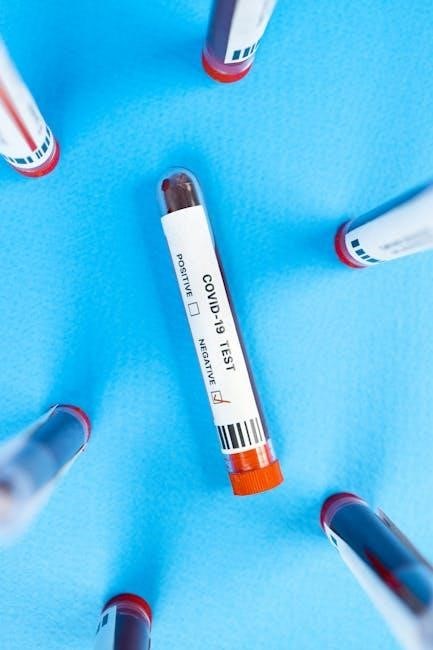Understanding Negative STD Test Results
A negative STD test result indicates no infection was detected at the time of testing, providing reassurance but not a lifetime guarantee. Factors like incubation periods can affect accuracy.
If symptoms persist or exposure occurs after testing, consult a healthcare provider for guidance and potential retesting to ensure accurate diagnosis and maintain sexual health. Always prioritize safe practices.
What Does a Negative STD Test Result Mean?
A negative STD test result indicates that the specific infection being tested for was not detected in your sample at the time of testing. This is typically reassuring, as it suggests you do not have the infection tested for. However, it is important to understand that a negative result does not guarantee complete safety, as some infections may not be detectable due to incubation periods or testing limitations.
For example, infections like HIV or syphilis require time to develop detectable antibodies, meaning early testing may yield false negatives. A negative result also does not account for exposure to other untreated partners or infections not included in the test panel. Regular testing and open communication with healthcare providers are essential for maintaining sexual health and addressing any ongoing concerns. Always follow guidelines for timing and frequency of testing to ensure accuracy and early detection if needed.
The Importance of Understanding Test Results
Understanding negative STD test results is crucial for making informed decisions about your sexual health. A negative result provides reassurance but does not guarantee immunity or lifelong protection. Recognizing the implications of your test results empowers you to take proactive steps in preventing future infections and maintaining open communication with partners. Misinterpretation of results can lead to complacency, potentially risking exposure or transmission. Accurate understanding also helps address concerns about false negatives, incubation periods, and test limitations. By grasping the meaning of your results, you can better navigate sexual health decisions, reduce stigma, and contribute to public health efforts. Clear comprehension fosters responsibility and promotes a safer, more informed approach to relationships and wellness.

Factors Affecting STD Test Accuracy
Test accuracy is influenced by incubation periods, timing of exposure, and test sensitivity. Early testing may miss infections, while false negatives can occur due to these factors.
Incubation Periods and Testing Windows
Understanding incubation periods and testing windows is crucial for accurate STD test results. Each STD has a specific incubation period, the time between exposure and detectable infection. Testing too early can lead to false negatives, as the infection may not yet be detectable. For example, HIV has a window period during which the virus is present but not detectable by standard tests. Similarly, other infections like chlamydia and gonorrhea have distinct timelines. Knowing these periods ensures testing occurs when the infection is detectable, minimizing false negatives. Consulting healthcare providers is essential to determine the optimal testing time, especially after recent exposure. This ensures accurate results and appropriate care.
False Negative Results and Their Causes
False negative STD test results occur when an infection is present but not detected. This can happen due to testing too early during the incubation period, before the infection is detectable. For example, HIV requires time for antibodies to develop, and early testing may miss the infection. Improper sample collection, such as inadequate swabs or urine samples, can also lead to false negatives. Additionally, some tests have lower sensitivity, failing to detect all cases. Certain infections, like syphilis, may not show up in early stages with standard tests. If symptoms persist or exposure is suspected, retesting is crucial for accurate diagnosis and appropriate treatment. Always consult a healthcare provider for guidance on timing and test accuracy.

Common Misconceptions About Negative STD Results
A negative result doesn’t guarantee complete safety or rule out all infections, as some STDs may remain undetected due to testing windows or asymptomatic cases, leading to false reassurance.
Believing a Negative Result Means Complete Safety
A common misconception is that a negative STD test result guarantees complete safety, eliminating all risks of infection. However, this is not entirely accurate. A negative result indicates no detectable infection at the time of testing but does not account for potential exposures occurring afterward. Additionally, some STDs, like HIV, have “window periods” where the virus may not be detectable despite active infection. Asymptomatic cases further complicate this, as individuals may unknowingly carry and transmit infections. False negatives, though rare, can also occur due to test limitations or timing. Therefore, a negative result should not lead to complacency; consistent safe practices and regular testing remain essential for long-term sexual health and safety.
Assuming All STDs Are Tested For
Many individuals assume that a negative STD test result implies they have been tested for all sexually transmitted infections. However, this is a common misconception. Standard STD panels often only test for a limited number of infections, such as chlamydia, gonorrhea, and HIV, depending on the clinic or provider. Other infections, like herpes or syphilis, may not be included unless specifically requested. This means a negative result only applies to the tests conducted and does not rule out other untreated infections. False negatives can also occur due to testing windows or asymptomatic cases. Regular, comprehensive testing and open communication with healthcare providers are essential to ensure accurate and complete sexual health assessments.

Why Regular Testing is Crucial
Regular testing is crucial for early detection of STDs, especially since many infections are asymptomatic. Early diagnosis ensures timely treatment, preventing complications and transmission to others.

Early Detection and Treatment of STDs
Early detection of STDs is critical for effective treatment and preventing long-term health complications. Many STDs, such as chlamydia and gonorrhea, can be asymptomatic, making regular testing essential for identifying infections before symptoms arise. Timely diagnosis ensures that treatment can begin promptly, reducing the risk of severe consequences like infertility, organ damage, or chronic conditions. For example, untreated HIV can progress to AIDS, while syphilis can lead to neurological damage if left untreated. Early intervention also prevents the spread of infections to partners, safeguarding public health. Regular testing, even for those without symptoms, is a proactive approach to maintaining sexual health and ensuring infections are caught and treated early.
STDs like HIV and herpes require lifelong management, while others, such as chlamydia, can be cured with antibiotics. Early detection ensures that individuals receive appropriate care, improving outcomes and quality of life. It also empowers individuals to take control of their health, fostering a culture of responsibility and awareness. By prioritizing early detection, individuals can avoid unnecessary complications and contribute to reducing STD transmission rates in their communities.
Asymptomatic Infections and Their Risks
Many sexually transmitted infections (STIs) can be asymptomatic, meaning individuals may not exhibit symptoms despite being infected. This poses significant risks, as undiagnosed infections can lead to severe health consequences, such as infertility, organ damage, or chronic conditions. For example, untreated chlamydia or gonorrhea can cause pelvic inflammatory disease (PID) in women, potentially leading to infertility. Similarly, asymptomatic HIV infection can progress to AIDS if left untreated, while syphilis can cause neurological damage over time. Asymptomatic infections also increase the risk of transmission to partners, as individuals may unknowingly spread the infection. Regular testing is crucial, even for those without symptoms, to ensure early detection and prevent long-term health complications and transmission risks;

What to Do After Receiving a Negative Result
Continue practicing safe sexual practices and maintain open communication with partners. Monitor for any symptoms and consult a healthcare provider if concerns arise. Consider retesting if exposure occurs post-test to ensure ongoing sexual health and safety.
Precautions to Prevent Future Infections
Even with a negative STD test result, it’s crucial to adopt preventive measures to reduce the risk of future infections. Practice safe sex by using condoms or dental dams consistently and correctly. Communicate openly with sexual partners about your sexual history and STD status. Avoid risky behaviors, such as unprotected sex or multiple sexual partners, which increase the likelihood of exposure. Stay informed about STDs and their transmission to make educated decisions. Get vaccinated against preventable infections like HPV and hepatitis B. Regular testing is also essential, as it helps detect infections early and prevents transmission. By taking these precautions, you can significantly reduce your risk of contracting or spreading STDs.
When to Consider Retesting
If you receive a negative STD test result, retesting may still be necessary under certain circumstances. Timing is critical, as some infections may not be detectable immediately after exposure due to incubation periods. For example, HIV and syphilis tests may require waiting several weeks before retesting. If you experience new symptoms or have engaged in high-risk activities since your last test, retesting is recommended. Additionally, if your initial test was conducted shortly after potential exposure, a follow-up test can confirm the accuracy of the result. Consulting with a healthcare provider is essential to determine the appropriate timing and need for retesting. Regular testing remains a key component of maintaining sexual health and preventing undiagnosed infections from progressing.

Interpreting Test Results in Different Contexts
Contexts like symptoms, exposure timing, and incubation periods influence result interpretation. A negative result may not rule out infections with ongoing symptoms or recent exposure, requiring further evaluation.
Understanding Results in the Context of Symptoms
A negative STD test result does not always rule out the presence of an infection, especially if symptoms are present. Common symptoms like genital discharge, pain, or sores can have multiple causes, including non-STD conditions such as yeast infections or urinary tract infections. If symptoms persist after a negative test, it is crucial to consult a healthcare provider to explore other potential causes. False negatives can occur due to testing windows or the timing of the test. Additionally, some infections may not be included in the initial screening. Regular follow-up and open communication with healthcare providers ensure accurate diagnosis and appropriate treatment, addressing both physical symptoms and sexual health concerns effectively.
Interpreting Results in Special Populations
Interpreting negative STD test results in special populations, such as pregnant women, adolescents, or immunocompromised individuals, requires careful consideration. For pregnant women, a negative result is reassuring but must be interpreted alongside clinical judgment to ensure maternal and fetal health. Adolescents may face barriers to testing, such as confidentiality concerns, which can delay diagnosis. In LGBTQ+ individuals, certain STIs may have different prevalence rates, necessitating tailored testing approaches. Immunocompromised individuals, such as those with HIV, may have false-negative results due to weakened immune responses. Healthcare providers must consider these factors to ensure accurate interpretation and appropriate management.
Regular screenings and open discussions about sexual health are crucial for these groups. Testing should be guided by individual risk factors and medical history to ensure comprehensive care and early detection of potential infections.

Resources for Further Information
For detailed guidance, refer to official health organizations like CDC and WHO. Support groups and counseling services provide emotional support and additional resources for understanding STD test results.
Official Guidelines and Recommendations
Official health organizations like the CDC and WHO provide comprehensive guidelines for interpreting negative STD test results. These guidelines emphasize understanding test accuracy, incubation periods, and the possibility of false negatives. They recommend regular testing for individuals at higher risk and highlight the importance of retesting after potential exposure. The CDC also stresses the need for open communication with healthcare providers about sexual history and symptoms to ensure accurate diagnosis. Additionally, these organizations offer resources, such as detailed PDF guides, to help individuals understand their results and next steps. Following these recommendations ensures better sexual health management and reduces the risk of undiagnosed infections. Always consult reputable sources for the most accurate and up-to-date information.
Support Groups and Counseling Services
Support groups and counseling services play a vital role in helping individuals process their experiences, even with a negative STD test result. These resources provide emotional support and guidance for those dealing with concerns about sexual health. Many organizations offer online forums and local meetings where individuals can share their experiences and connect with others. Counseling services, often led by healthcare professionals, can address lingering worries about false negatives or future risks. These services also educate individuals on maintaining sexual health and understanding test results. Additionally, they provide access to resources for prevention and offer tailored advice based on personal circumstances. Engaging with these services can empower individuals to make informed decisions and reduce anxiety related to sexual health.

Technological Advances in STD Testing
Advances in STD testing include home kits and digital platforms, enhancing accessibility and result delivery. These innovations improve accuracy and convenience for users worldwide.
Home Testing Kits and Their Reliability
Home STD testing kits have gained popularity due to their convenience and privacy. These kits allow individuals to collect samples in the comfort of their own homes and receive results quickly. While many home tests are FDA-approved and highly reliable, their accuracy can vary depending on the type of STD being tested and the sensitivity of the kit. Properly following the instructions is crucial to ensuring reliable results. Some kits may produce false negatives, particularly if the infection is in its early stages or if the sample is not collected correctly. Despite these limitations, home testing kits provide a valuable option for individuals who prefer discreet testing or have limited access to clinical facilities. Regular use of reliable kits can help identify infections early, promoting timely treatment and reducing the risk of transmission.
Digital Platforms for Result Access
Digital platforms have revolutionized how STD test results are accessed, offering convenience and privacy. Many clinics and testing services provide secure online portals where individuals can view their results within 1-2 days. These platforms ensure confidentiality, with results accessible only through personalized accounts. Digital delivery allows for quicker dissemination of information, enabling individuals to take prompt action if needed. However, it’s important to ensure the platform is reputable and adheres to privacy laws. Some services also offer consultations with healthcare providers directly through the platform if results are positive. This integration of technology streamlines the process, making it easier for people to monitor their sexual health effectively and maintain confidentiality throughout the process.

Legal and Ethical Considerations
STD testing involves strict privacy laws ensuring result confidentiality. Ethical guidelines mandate informed consent and transparent reporting. Testing must respect individual rights and promote fair, unbiased practices.
Privacy Laws and Test Result Confidentiality
Privacy laws, such as the Health Insurance Portability and Accountability Act (HIPAA) in the U.S., protect the confidentiality of STD test results. These laws ensure that personal health information, including negative STD test results, is securely stored and shared only with authorized individuals. Patients have the right to control who accesses their results, maintaining their privacy and dignity. Digital platforms providing test results must comply with strict data protection regulations to prevent unauthorized access. Breaching confidentiality can lead to legal consequences, emphasizing the importance of adhering to privacy standards. This ensures trust in the healthcare system and protects individuals from potential discrimination or misuse of their health data.
Ethical Implications of Testing and Reporting
Ethical considerations in STD testing and reporting emphasize the importance of informed consent, privacy, and transparency. Providers must ensure patients fully understand the implications of testing, including the possibility of false negatives or positives. Reporting positive results to public health authorities is crucial for disease control but must balance individual privacy rights. Ethical dilemmas arise when false negatives may lead to undiagnosed infections or when results are disclosed without consent. Ensuring accurate and timely communication of results, while respecting patient autonomy, is essential. Confidentiality must be maintained to prevent stigma or discrimination. Ethical guidelines also stress the need for culturally sensitive and non-discriminatory testing practices, ensuring equitable access to care for all individuals.
